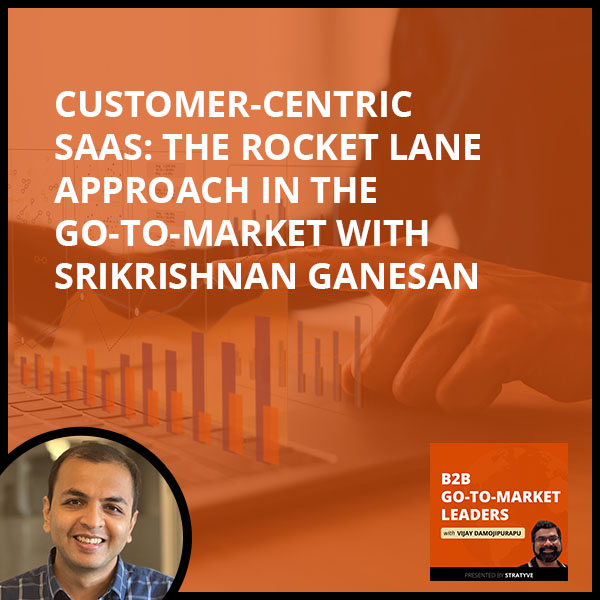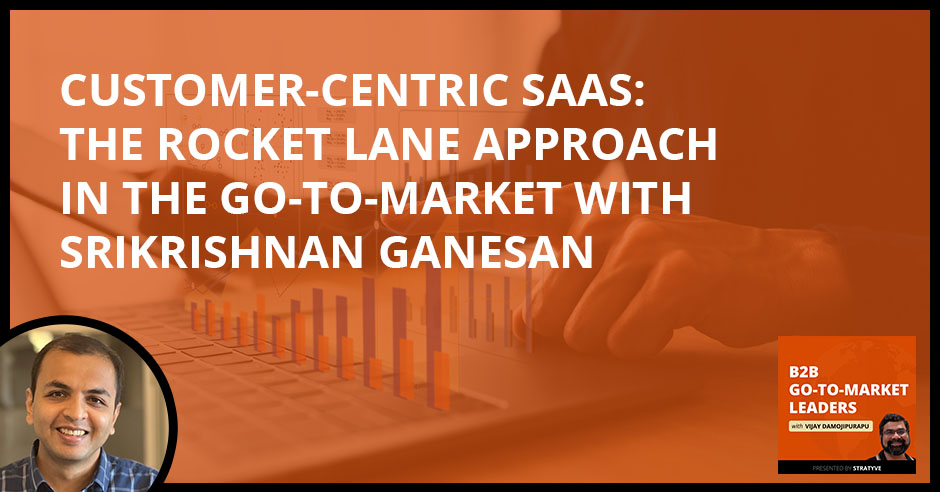

Success in the world of SaaS requires relentless customer focus, strategic community building, and the courage to pivot when you face go-to-market challenges. In this episode, we sit down with Srikrishnan Ganesan, the founder and CEO of Rocket Lane, to discuss the work behind building a successful go-to-market strategy. Srikrishnan shares his journey from launch to scale, revealing how Rocket Lane became a rising star in the SaaS industry. He shares the power of staying close to your customers, using their feedback to shape product development, and building a brand that resonates across LinkedIn and beyond. Srikrishnan also explains the importance of recognizing and rectifying go-to-market failures. He shares how learning when and how to pivot and adapt has shaped Rocket Lane’s growth. Moreover, Srikrishnan reveals his unique approach to identifying your target audience and creating tailored content, emphasizing the impact of rapid iteration and experimentation in the early stages of growth. Hear the founder’s journey and learn the art of scaling success.
—
Listen to the podcast here
Customer-Centric SaaS: The Rocket Lane Approach In The Go-To-Market With Srikrishnan Ganesan
I have the great pleasure of hosting another successful founder in a B2B tech startup world. His name is Srikrishnan Ganesan. He is the Founder and CEO of Rocketlane. I’m excited to have you on the show.
Thanks for having me on.
This has been a trend in our show off late, which is you are one of the references from a previous guest who came on the show. I’m grateful and happy about the fact that guests are referring other guests. It also goes to show how well-connected you are within the startup community.
We have a nice community that’s been growing, helping each other out, and learning from each other. I am glad to be part of it and excited to see all the progress many companies are making like a cohort of companies that start around the same time. Everyone is growing, learning, and evolving.
Let’s get right into the meat of the topic, which is how do you view and define go-to-market?
The way I view and define go-to-market is there is a series of motions that need to be in place. Part of it would fall under the marketing side and sales side of things typically, but it’s about how you are creating a presence for yourself in the market and getting your product into the hands of customers. Part of it is audience building, getting people to come in and check out your offering, and outreach you’re doing, like the outbound motions that you may have. How are you even messaging this? How are you crafting the right story for what you’re selling? This can be taken by many marketing channels, and one is to one channel to the right audience to pull them in and convince them to buy. That whole journey is what I view as go-to-market.
You touched upon quite a few things that I want to echo and highlight. You talked about the connection between product marketing and sales. That’s one piece. Second, you talked about audience building and community building. We’ll dive into that pre-flight community that you have been building. That’s a second aspect.
Third is the storytelling aspect. All of these pieces have to come together to connect the dots between what is a pain point? Who is a pain point? Who are you addressing it for? How is your product solving it? Let’s step back, take a bigger picture of your career, and walk us through your career journey and what led you to what you’re doing NOW.
Deep in my heart, I’m a coder. That’s what I enjoyed doing through my undergrad years. I surprised myself and others around me. I went to B-School immediately after my undergrad, but I was still in love with technology and creation. I was like, “I want to be a product manager.” I found a career in product management at Verizon and an Indian company called Rediff.com. Think of it as the Yahoo/AOL from India, an early web property. It’s stuck in between being a media company, a product company, and a tech company in a way.
I joined a startup as the Head of Product in a company called Jigsee, which was acquired by another startup a few years later. That journey gave me a lot of confidence in building not a product but a company because I was one of the first three employees. Three of us joined on the same day. I built the team and company and looked for office space. You need to have a certain false sense of how easy it is. You need to be a little delusional to start. That delusion had happened at that time. I was like, “I did it at Jigsee. I can do it on my own. Let me go and do a startup.”

I pulled in a couple of friends. Three of us were excited to start on a journey. We started with something B2C and pivoted into B2B in the messaging space. We were trying to take on WhatsApp and pivoted to do B2B messaging SDK. That startup was acquired by a company called Freshworks in 2015. The three of us continued to build that business within Freshworks for the next several years. That was going to a SaaS school in a way for us. We learned a lot in that journey. We decided it was time to graduate and try something on our own again. In 2020, we started Rocketlane. That’s been my career.
You got into product management with Verizon and the FiOS TV. As a side note and related notes, I was at Microsoft Media Room, the IPTV platform, doing product marketing. Our worlds crossed back then. We didn’t know each other back then, but I can relate to that world of yours. You switched to Rediff. You also mentioned being an early employee at Jigsee and Konotor. That’s the startup that you co-founded, which was acquired by Freshworks. Now you’re onto your second official startup, which is Rocketlane.
It’s been a fun ride.
Given this varied path, how do your family members describe what you do?
They know I do a ton of things. I’m on customer calls quite often. They know I always, from Jigsee days to Konotor days to now, do a bunch of customer support myself. I’m jumping on not just escalations, but if I have free time and see someone chatting with us, I would try to jump on that. For them, it was like, “He runs the company. He’s a CEO at a high level.” They know I do that. I am more on the sales side in our startup. That’s how much they know.
You seem to do and come across as everyone or every role for your family. If you are a founder, you need to wear multiple hats, and the fact that you have a supporting family gives you the space, time, and energy, which says a lot about the family support you are having. Coming back to what you were doing at Rocketlane in the early days, walk us through it. What is Rocketlane? What prompted you to go down this path? Who do you serve in this space?
This stems from personal experience. We look back towards the end of our journey in Freshworks. What was a broken experience for us or our customers in the whole seven and a half years we spent building this business? We were thinking, “Are there teams that were underserved? Are there experiences that were playing wrong?”
One thing that stuck out was the implementation journey. You’ve sold an amazing deal, and now you’re worried. We sold all of that. We’re going to transfer that context to the implementation team, but who do we put on that team? You have some heroes in mind from the team. You are like, “If I give it to Sodir, he’s going to do a great job, but he’s already doing these three other big projects. Who’s going to manage this? If I give it to someone else, will they do a sloppy job?”
It’s hero-driven as an experience. It’s the first partnership that the customer is experiencing with you. Post-purchase, the first partnership. A lot of people on the customer side are in the dark about what’s happening. A leader on the customer side only knows, “It’s been several months since I purchased this. We are not yet live.”

You may have reasons to say, “No, it was your team. Here is where the problems were. This integration didn’t work.” There are excuses but when you think about it, the ball is always in your court. That’s how you should treat it. That’s where we said, “There is scope for something different.” Instead of using a bunch of ad hoc tools like Slack, Asana, Notion, Google Docs, email, SurveyMonkey, or all of that together in this implementation journey, what if we build one all-in-one experience that is purpose-built for running customer-facing projects?
We didn’t say to just implement it. We said, “Let’s go after customer-facing projects of all kinds where there is an internal team, external team, and potentially a partner team. They’re using a bunch of silo tools. Let’s stitch together those experiences.” If you’re running a services team within a product company or a services business, you also want to learn where people are spending time. You want to tie effort to revenue from that project.
There are the PSA capabilities, time tracking, resource management, rate cards, and project accounting. We brought together all of that as one offering. We play in two key categories. PSA, Professional Services Automation, and client onboarding. That’s what the tool helps with running customer-facing projects and services projects. How do you hold each other accountable? How do you provide a better customer-centric experience? How do you automate a lot? Because it’s purpose-built for these projects, there’s a ton of automation that’s never been dabbled in before that we are able to enable.
That’s what the best founders do, which is to figure out what is the problem that they saw firsthand. They build a hypothesis around it. They go about validating the problem and building a solution for those personas. Coming from Freshwork and even at the early time in your prior startup, you had that hypothesis that onboarding and implementation were potential pain points, but that’s in your mind. How did you go about validating? You need to have that customer validation for the first 5 to 10 early adopters or beta participants. How did you go about doing that?
We didn’t write a single line of code, launch an MVP, or do any of that early on. We said, “Let’s focus on validation. Let’s talk to as many people as we can.” We took two and a half to three months. We spoke to around 60 to 70 companies. We spoke to different roles in these companies. We spoke to the CEO, CCO, implementation leader, and implementation manager. We want to get all the perspectives. Some of them are their investors.
Is this a big problem? Does this problem have visibility? Is there value assigned to or related to solving the problem? Is it one of the top five problems for the company? Is it one of the top five problems for the CCO? We want to know, at each level, where this priority for solving this problem lies. One thing we found was there are enough companies, especially within SaaS, which is what we started with as our beachhead, where people cared a lot about that time to value and launch.
The reason was time to value creates a stickiness. Time to launch is essential for pulling forward revenues. Closed ARR is far ahead of your live ARR because a lot of customers are stuck in implementation. That’s what investors and CEOs cared about. On the other hand, when we talked to the CCO and implementation head, we got a little more perspective on what are their key challenges. They want to hold customers accountable in a better way. They want more automation and streamlined experiences. They want their teams to follow the playbook the right way.
All of those problems came out. We started thinking. How can we solve all of this? What experiences will help? We use an approach called jobs to be done to build a product. Before we build a product, we want to understand the jobs to be done by the people and the software we build. We came up with the right hypothesis of what can help these people. Is it a people problem, a process problem, or a system problem? Where they see it as the problem, there should be elements in the product that can help them with the people problem, process problem, and the system itself.

That’s the journey we took in early validation. We spent enough energy on it. We talked beyond what we felt was our ICP because early on, we said series B plus companies is what we want to focus on. Opportunistically, we’ve met an early-stage founder. We’ll also talk to them and understand how they think about this.
It helped because we uncovered that an early-stage company, a seed series A and early series B type company, somehow made things work on time. That’s the only thing they focus on. They have only a few customers. They make things work but then they want to come across as professional. That was their problem. They wanted to look bigger than they were and make an impression. “We said, “That’s also a problem we should try to solve.”
The last point you mentioned boils down to the messaging. Messaging to a persona or ICP that is pre-series B versus messaging to a post-series B would be different. That’s the early validation phase. You said that you spoke to 60 to 70 people in a 2 to 3-month timeframe. At the end of the three months, is that when you had a good idea of the product hypothesis and business model?
We started working on high-fidelity prototypes of what we felt were key experiences that the product needs to enable and key problems that need to be solved. Beyond that first three-month period, we started to build the basic building blocks of the offering. We also started to show people these early prototypes and marked click-through prototypes to say, “We don’t have a product yet. We are not selling to you. You described the problem before. We want to show you how we are thinking about the solution. Let us know if this resonates with you. Let us know if you think this will solve the problem or if there’s something else that could be magical in this experience.”
We started doing that over the next year. We didn’t launch an MVP. We launched a full-featured product. Along the way, we kept showing the product and the prototypes to more people. I had a notion document with 120 companies, the contact, what feedback we were hearing from them, and what stage they were in from the conversations I had in that period where only the conversations that I felt were worth pursuing. I added it to this list. Having a CRM. We had a notion table with all of this data. When we launched, we went out to all of these folks.
This was in April of 2020 when you officially came out, and you incorporated Rocketlane.
That’s when we incorporated. We came out in June 2021.
Something else that caught my attention, and kudos to you and the founding team, is you built a community from the early days, the pre-flight community starting in September of 2020.
That was nine months before we launched our product, which is unique. Most people think about it after some traction.
Many people don’t even think about it.
Two things happened here. One is as we had these conversations with people, I wasn’t focused on what the software does. I was trying to understand the people problems, the process problems, and the system problems. I could see that different kinds of companies were focused on solving different pieces of the problem.
Some of them that were more enterprise were more focused. They were like, “I’m holding customers accountable. I need a steering committee so that the key decisions are made on time.” There were some folks that talked more about how you start the journey matters so much. Start with the right intensity. What do you do at kickoff matters? In every conversation I had, I would ask them about where things were several months ago. How have you evolved? What are you focusing on improving?
There was so much learning for me personally on what people were trying out to solve problems and implementations launch faster, giving a better experience for the customer. If everyone is focused on different things, its implementation feels like one part of the customer journey, but it’s a complex part. If I get these people to talk to each other, there’s so much cross-pollination of ideas that can happen. All of them can benefit.

I invited one of my friends who said, “I used to have a six-month-long implementation. I’ve shortened it to six weeks.” I was like, “Tell me more. I’m open to talking about this to a wider group of founders and practitioners.” He said, “Yes. Organized a session.” We called it an implementation story session where he talked about all of it. There were many questions and engagement.
Was it a Zoom virtual or in-person session?
It was Zoom. This was during the pandemic. The session was very engaging. There were 25 people who joined. There are many questions. I was like, “He’s got to go. We can continue the conversation on Slack. Let me create a Slack group.” That’s what turned into pre-flight the community because I already wanted to do the community.
This became the catalyst for that action to happen. We said, “Every month, we are going to invite two people to talk about how they have evolved their implementations, and let’s all learn together.” It was a great source of content and building an audience because we started reaching out to folks about these events. We said, “Join the community to get access to the events.”
Did you invite that speaker? Did you have that first session after your 60 to 70 conversations or even before?
It was after the first 60 to 70 conversations.
We can deep dive into this topic alone, but we’ll save that for another time. You are several years old now. You are yet in terms of number of customers, revenue, and funding.
We keep the revenue part private. We have over 400 amazing logos that have come on board. It’s companies like Clari, Drift, Mixmax, Vidyard, Unifor, Amelia, and a whole bunch of amazing logos globally. We raised $21 million of funding to date. That’s an $18 million series A and a $3 million seed that we did. Things are on a great track from the momentum perspective, given it’s a few years from launch.
Thank you for sharing your growth story and journey. That’s commendable. I’m excited and happy for you guys and the way you’ve been validating the problem and building your company, Rocketlane. I’m switching gears a bit here. Let’s talk about a go-to-market success story and a go-to-market failure story. It can be for you when you are building Rocketlane or any of your customers.
I would say go-to-market success story. I’m going to use the example of what we did on G2. Early in the journey, we said, “We need to get a good presence on G2.” We saw that we had few competitors at the early stage in this category called client onboarding. The highest one had 80 reviews, and it felt beatable. We had 30 customers in the first two months since launch. It shouldn’t be hard if people like the product to get them to review it. That’s something we focused on.
It wasn’t like marketing owns it. It was like all of us owned it between customer success, which drove a lot of sales, marketing, and anyone in the company. If we knew there was a customer who had had a good experience with us, we would pounce on them for a G2 review. We push them to rate us and give that ranking. We are number one on G2 in our category. We are the highest rated and highest number of ratings in the category.
I’m proud of what we accomplished over there. It has a big impact because, in the early days, we focused a lot more on SMB. Now we have a lot of mid-market and above-type customers, but all these folks search for tools and alternative tools. If you come up in the top 2 or top 3 on a platform like G2, you make it into the consideration set. The number one always has a lot more momentum in the sense that people consider that first. They talk to them first, and they ask the others, “How do you differentiate from the number one?”
In that sense, it puts you in a poll position in any competitive evaluation. That’s what you want. That would be a success story. There are a lot of tactics and specific things we did to get that momentum on G2. We are happy to chat one-on-one with people on that, but it was a great investment of our time and energy for that phase of our journey to get up to being number one in that space.
If you can share 1 or 2 tactics, what drove the success that would be helpful for the readers?
If someone has a support issue they came up with, and you delivered a good experience for them, and they say thank you, that’s a moment for you to latch on and say, “We are always happy to help you. We’d also be glad if you’re able to help us and leave a review for us on G2. It means a lot for us as a growing business.” Add that emotional appeal, ask them, and they will do it.
The other thing we did is if you give something, you get something. Sometimes, customers ask for discounts, especially early in the journey. We said, “If you want a discount, we give you this discount, but in return, we need G2 reviews from your team.” We can’t control what they say in the reviews, but we push people to give us those reviews. There are ways to incentivize.
We can't control what customers say in the review, but we can push them to give us those reviews. Share on X
When I was running go-to-market and marketing teams and even product growth in previous companies, that was one of the tactics that we used to do, which is to run an email campaign and a phone LinkedIn campaign and even offer gift cards. Gift cards are more to get attention. I’ve seen the quality of reviews not necessarily tied to the value of the gift card. It’s more of how happy that customer is with that product or service. Gift card is a little cherry on the topic. Now go-to-market failure story because we all know it’s not success all the way. How about a go-to-market failure story?
There’s a big lesson from my previous journey. I don’t know if your show reaches more early stage and late stage. There’s a big lesson for anyone in the early stage, at least from my previous journey. We launched this SDK that went into other people’s apps and enabled rich conversations between customers using apps and businesses.
Is this from your time at Konotor?
This was Konotor. Even inside Freshworks, we first relaunched as Hotline.io. We had the same problem go-to-market problem over there. This was an evangelical product in the sense that people weren’t looking for it yet. They didn’t know that they could deliver a WhatsApp or iMessage-style experience inside their app and why they should do it. We had to educate the market a fair bit.
We were ahead of the game in the journey already because we had to go, educate the market, and tell them about how this would create a better experience for customers and how that would lead to stickiness for their apps. Most apps, back in 2012 and 2013, were still figuring out what their app should do. They weren’t in a frame of mind to say, “I need to improve the support experience inside my app. Who should my app serve, firstly?”
When we showcase this, there are companies of all kinds. There was enough feedback we got saying, “Can you also provide this for the web? We want to use one platform for web and mobile.” We did not listen to the customer and not even to our own sales manager. We said, “The experience for web live chat is different from WhatsApp-style asynchronous communication. That’s what we are focused on. We don’t want to dilute it by trying to serve someone else.”
The reality was no one in this mobile messaging space, and the mobile SDK space grew fast. Everyone was slow and chunky growth. On the other hand, there were companies like Intercom and Drift doing what we did for web apps. They were growing like crazy. We completely missed the bus on that. We could have been there. We could have been growing that fast as a bootstrapped startup, and we missed that completely. The size of the market and a real validation of who will buy, why they will buy, and what the priority is. We missed all of that in our thinking about going to market. That is one weakness.
The reality was no one in this mobile messaging space mobile SDK space grew fast. Share on XHow are you fixing that at Rockelane, where you’re not missing out on those big signals that are coming out?
If we didn’t have the momentum we had in the first two months, we would have pivoted immediately. Optimizing for momentum is the learning over there for us. What that also means is you can’t do anything in a half-hatted way where you’re thinking, “Was it A or B? Was it because I didn’t do enough marketing? Was it because I didn’t have a good brand? Was it because I didn’t have the right message?”
You should test out everything quickly. You shouldn’t be like, “I’ll spend six more months and then I figured out maybe it’s the message or I need to change that.” There needs to be rapid attrition and a lot of early validation of the messages before we even launch the product.
That’s been how we’ve approached things at Rocketlane. When you’re doing something, do it in a way in which there’s no second guessing on why it did not work and extending the timeline of an experiment to say, “It didn’t work. Let me try something else for a longer period of time.” We started doing Google Ads early because we wanted to understand, “Will this be a channel that will scale for us? I didn’t want to wait it out until a certain point in time and a certain number of customers before spending on ads. Let’s do it.”
What also surfaces in my mind when you’re sharing this story is the role of product marketing. Early on, especially in the early days with the founders who are wearing the head of product marketing, and as you scale, it looks like you’re at 80, 85, or 90 employees at Rocketlane. As a founder and CEO, what is your message to your product marketing team? What are the challenges that they’re dealing with?
The big thing that we focus on is people are actively listening to customer conversations every day, whether you’re in marketing, product marketing, or other functions. Even our engineers listen to customer conversations because you build context on what the pain is for the customer, what words resonate with them, and how they describe their problems when you listen to it from the horse’s mouth.
Listen to customer conversations because you build so much context on what is the pain for the customer and what words resonate with them. Share on XThere is nothing better than building context together. From day one, we’ve recorded every single conversation we had, even those first 60 to 70 conversations, before we decided what to do. Every prospect conversation is recorded. We use Avoma. We auto-generate these summaries that get posted on Slack. People read that. That’s a trigger for them to go and watch a conversation.
The biggest thing is how we build a common context. I don’t even have to say anything. People know what’s happening. What does the customer care about? From a direction perspective, we want to set direction by saying, “We want to focus on that mid-market customer. Watch out for more of these calls. We are trying to sell to services companies, not services teams and SaaS companies, or the message needs to change for that audience. Who do you want to talk to? Let me facilitate.”
We had fifteen service leaders do sessions for us. They did it pro bono out of the goodwill of their heart. There’s a promising company that’s taking a certain direction. Let’s spend time with that team. Let’s tell them about our world. If people get curious, they will ask questions. Validate like, “What’s the top priority? How would you describe this problem? What do you think will solve this problem?”
The way I look at product marketing is you can break it down into 6 to 8 categories or programs. You have the positioning, messaging, customer insights, competitor insights, sales enablement, new product launch, new market launch, product content, and product adoption. You have ticked the boxes, especially in the early days, where you have focused on the customer insights program and making sure that every employee, not just marketing or sales, is listening to these customer conversations.
Going forward, something that caught my attention is you mentioned going upmarket. It looks like if you were to pick an area that you want your product marketing leader or marketing leader to focus on for your go-to-market, which would that be? Would it be like a new market, product content, or product adoption?
It is honing in on this new market we’ve landed on and ensuring that we are enabling the sales team to approach that market the right way. We’re doing a lot of enablement sessions internally. We focused on that.
Given that you’ve got a good track record when it comes to early company building and fundraising, what are the 1 or 2 things, especially when it comes to go-to-market, that industry peers or folks from your network reach out to you for? They go, “This is something that Sri is good at. Let’s go reach out to Sri.”
There are a few things I would say. One is marketing. People keep reaching out because we have quite a buzzing social presence like LinkedIn presence. People reach out about that. It’s more brand than demand gen or other stuff. Community and brand are areas where I think people keep reaching out and sales momentum. Early-stage founders reach out about the 0 to 1 journey, which we did within our first year of launch. That was a fun early first year for us. A lot of people have heard about that. They reach out to ask about what are things that you did, mistakes, and learnings from that early journey.
You have all the items in a successful or winning go-to-market. It was around content.
Another area where people reach out is if they have problems with their implementation or onboarding.
It goes without saying I was diving deeper into what other, besides your core offering and core expertise. The point I mentioned earlier is you have all the key ingredients and elements when it comes to winning go-to-market, which is the content. You have community and experience/events. It goes back to doing that early reach out, validating the problem, and building content around it, which is your presence on LinkedIn and others. You have the community, which is a pre-flight community, and experiences and events. You must be running some customer events and having a good presence in industry trade shows.
That’s an area we pride ourselves on in terms of in-event execution. In pre-event planning, we could do better. At the event, we are the hungriest team, and we do some unique things over there.
We’ll save that for another episode. I have the last couple of questions. I know you need to head back to your company building days. The two questions I have for you are, who are the 1, 2, or 3 people who have played and shaped your career growth, and who have played a key role in your career growth and inflection?
One is Girish Mathrubootham, the Founder of Freshworks. I got to work closely with him. I’m a huge admirer. I learn every time I meet him. I learned something from him. I would say Krish of Chargebee. He is another founder that I have. I get different perspectives from Girish and Krish on a lot of things. I need to figure out what I want to do. It’s good to pick their brains and get that different perspective. There are many founders, like Ashwini from Mad Street Den and Sahil from Rattle. There are a lot of folks who are on similar journeys with us. I’m big on community. The same applies to the founder community. I’m actively learning from a lot of people.
That’s a key ingredient. It doesn’t matter which part of your go-to-market journey you are in, early days, or even the growth and scale phase. It’s important to have a personal board of advisors. You’re building that. Do you carve out an hour a week? Is it one hour a month? What is your focus in this area?
It’s sometimes more reactive, but I have cadences with 3 or 4 founders. We have it on the calendar for one hour a month to go over a bunch of things together.
The final question for you is, if you were to turn back the clock, what advice would you give to your younger self on day one of your go-to-market journey?
Hire leaders faster.
Why is that? Why did you come to that realization, and when?
We hired a sales leader who’s been impactful. It’s given me more time and energy to focus on other things. It tells me, “If we make the right hires earlier in the journey, it makes it easier for everyone, including the teams you’re building.” You can do more justice to your team if you get them to work with a great leader.
If we make the right hires earlier in the journey, it makes it easier for everyone, including the teams you're building. Share on X
Thank you so much for your time, Sri. I enjoyed the conversation and the actionable insights that you shared with the readers. Good luck to you and your team at Rocketlane.
Thanks so much, Vijay.
Important Links
Love the show? Subscribe, rate, review, and share! http://stratyve.com/
